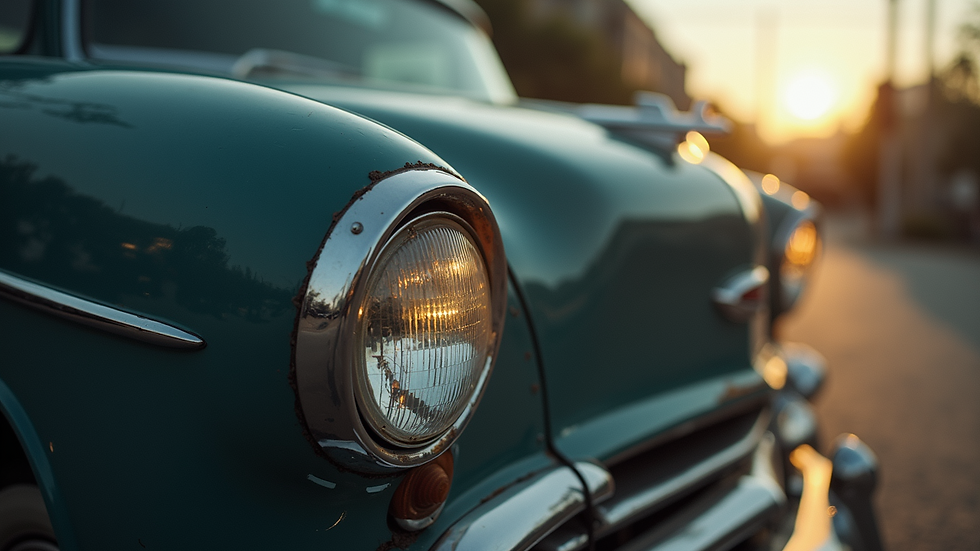Understanding Cloudy Headlight Restoration: The Process Behind Fixing Deteriorated Plastic
- bayden85
- Aug 2
- 3 min read
Keeping your vehicle's headlights clear is essential for safety. Cloudy or yellowed headlights can significantly reduce visibility, especially at night or in bad weather. In fact, studies show that poor visibility contributes to nearly 50% of nighttime accidents. This blog post explores the process behind restoring cloudy headlights, including what leads to degradation and how effective restoration techniques can bring back clarity.
What Causes Cloudy Headlights?
Most headlights are made from polycarbonate plastic. While this material is lightweight and durable, it deteriorates over time due to several factors:
UV Exposure: The sun’s ultraviolet rays can cause plastic to oxidize, resulting in a dull, cloudy appearance. Research indicates that regular exposure can reduce light output by up to 80%.
Environmental Factors: Dirt, road grime, and harsh weather can further degrade plastic. For example, heavy rain and snow can introduce chemicals from road treatments that weaken the surface.
Chemical Damage: Common car cleaners and environmental pollutants can cause damage. Over time, even minor chemical exposure can lead to significant deterioration.
Recognizing these factors underscores the importance of regular maintenance and restoration for safe driving.
Signs of Deterioration
The signs of deteriorated headlights may start off subtle but can become pronounced. Watch for these indicators:
A distinct yellow or brown tint on the headlight surface.
Noticeably reduced brightness when the headlights are on.
Difficulty seeing clearly at night or during conditions like rain or fog.
If you observe any of these signs, it is time to think about restoring your headlights.
The Headlight Restoration Process
Headlight restoration is a systematic process that can be done at home or by a professional. Here’s how it typically works:
Step 1: Cleaning the Headlights
First, the headlight surface is thoroughly cleaned to eliminate dirt, grime, and wax. This step is vital for preparing the surface for effective restoration.
Step 2: Sanding
Next, sandpaper of varying grits is used to sand down the cloudy surface. This step can often take about 10-15 minutes and removes the top layer of oxidized plastic. Sanding creates a smoother base for the next steps.
Step 3: Polishing
Once sanding is complete, a polishing compound is applied to restore clarity. This step is important because it helps eliminate fine scratches and enhances the shine of the headlights.
By following these steps, you can transform clouded headlights back to their original crystal-clear condition.

What Happens to the Plastic?
Before restoration, the headlights are often rough, discolored, and less transparent due to oxidation. This layer obscures the light emitted, hindering visibility.
During the restoration process, this damaged layer is carefully removed, revealing fresher plastic underneath. After sanding and polishing, the plastic regains its original clarity, making the headlights look nearly new.
DIY vs. Professional Services
When considering headlight restoration, many car owners must decide between DIY methods and professional services. Here are key considerations for each option:
DIY Headlight Restoration
Costs: DIY restoration can be budget-friendly, requiring only sandpaper, polishing compound, and sealant. Expect to spend around $10 to $30.
Time: While you can restore headlights yourself, it may take some trial and error. Overall, you might invest 30 minutes to an hour for effective results.
Skill Level: If you feel comfortable tackling home projects, DIY can be a satisfying challenge.
Professional Detailing Services
Quality: Professionals often achieve better results because of their experience and specialized tools. Expect costs to range from $50 to $100, depending on your area.
Convenience: Allowing professionals to handle the work saves time and effort, letting you focus on your daily responsibilities.
Comprehensive Care: Many mobile detailing services include headlight restoration as part of a complete vehicle package, which might include interior and exterior cleanings.
The choice between DIY and professional services depends on budget, desired quality, and personal comfort levels.
Keeping Your Headlights Clear
After investing in headlight restoration, it's crucial to maintain their clarity. Here are some practical tips:
Regularly wash your headlights when washing your vehicle to remove dirt and grime.
Apply a UV protectant every few months to shield your headlights from environmental damage.
Avoid harsh chemicals, which can strip protective layers and exacerbate deterioration.
Whenever possible, park your vehicle in a garage or shaded area to minimize sun exposure.
Implementing these maintenance strategies can help extend the life of your restored headlights and keep your vehicle looking sharp.
Final Thoughts
Cloudy headlight restoration is not just about aesthetics; it’s essential for ensuring a safe driving experience. Understanding what causes cloudiness and learning the restoration process helps vehicle owners make informed choices. Whether you choose a DIY approach or professional services, restoring your headlights is an investment worth making. Enjoy a safer drive and an attractive vehicle with clear, bright headlights!



Comments